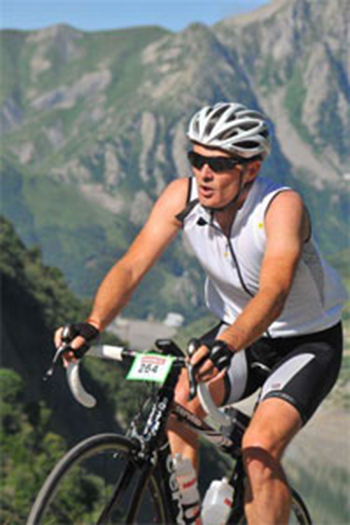
Michael Pinchen
Occupation: Company Director and Semi-retired
Primary Sport: Cycling
“After six months training in tandem with ithlete, I hit the same climb and was delighted to see a 7 percent improvement in my personal best time.”
Over the past few years I have increased the seriousness with which I have trained. My goal, as I approach 50, is to buck the trend and continue to improve despite the onset of middle age and attendant slowing of metabolism. I knew this would take a lot of work.
These days I’m training 10 hours a week. That’s risen from 4 or 5 hours in the past. I have been reliant on heart-rate monitor data for many years. But the most noticeable impact of the onset of age has however been the length of recovery time needed after hard efforts. Combined with the increased level of training, this has led to overtraining syndrome on more than one occasion, as well as a general loss of energy and sporadic loss of form. This is where ithlete has really been a game-changer for me.
The ithlete was an unexpected birthday present from a friend. I’ll be honest and say I was unconvinced at first, but once I started using ithlete, an initial fascination with daily resting heart rate was been replaced by growing understanding of heart-rate variability and its impact on my training regime.
The one point I would make to any prospective purchaser of ithlete is to persevere. It took me three to four months to really appreciate ithlete’s benefits and be able to identify trends that have had a genuinely positive impact on my training and performance.
What ithlete has allowed me to do is to make better use of my time – to target my training in a far more precise manner than before. In addition, it has gone a long way to explaining dips in performance and in so doing has prevented me from overtraining by way of compensation. I’m now happy to occasionally take a rest day out from my schedule – and be safe in the knowledge that it is doing me good in the long term.
In the past, often my legs would feel fine so I would hit the road only to find my energy levels were way down. On other days, my legs would feel stiff and I would spend the day relaxing on the sofa. Now I can be pretty sure whether the stiff legs will recover after ten minutes of hard effort, or whether feeling good on the sofa with a cup of coffee will translate to meaningful training on my local training loop.
On this loop, there is a 12-kilometer climb that I’ve used as a benchmark for a few years. For the last couple of seasons, however, I’ve been unable to improve on my best time regardless of increases in training and noticeable weight loss. Having spent the last six months training in tandem with ithlete, I hit the same climb and was delighted to see a 7 percent improvement in my personal best time. Perhaps I could achieve the same results with a personal coach and sports science monitoring but frankly I could not afford such luxuries even if I had access to them.
The results I’m achieving this season make me a true believer in the benefits of HRV when used as part of an organized training regime. I’ve learnt to trust it. I’m beginning to understand my body’s recovery cycles and the effects of both physical and mental stress on my performance. The ithlete has even improved my energy levels away from the bike.
